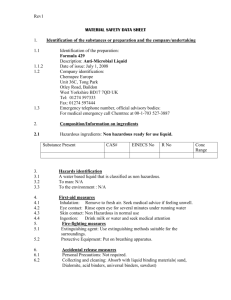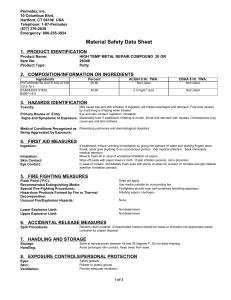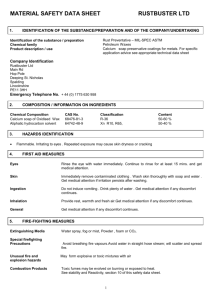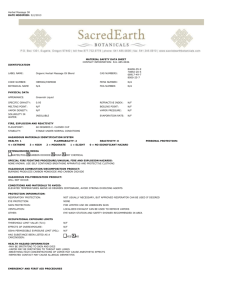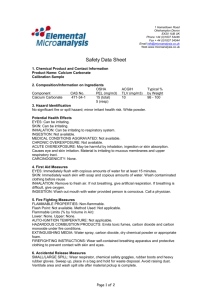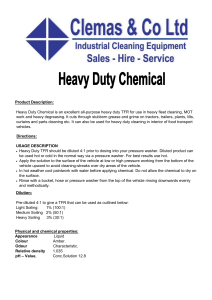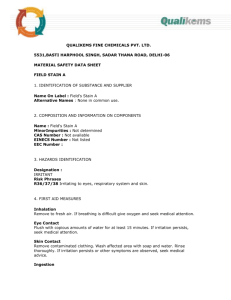safety data sheet acid etch cleaner (1302)
advertisement
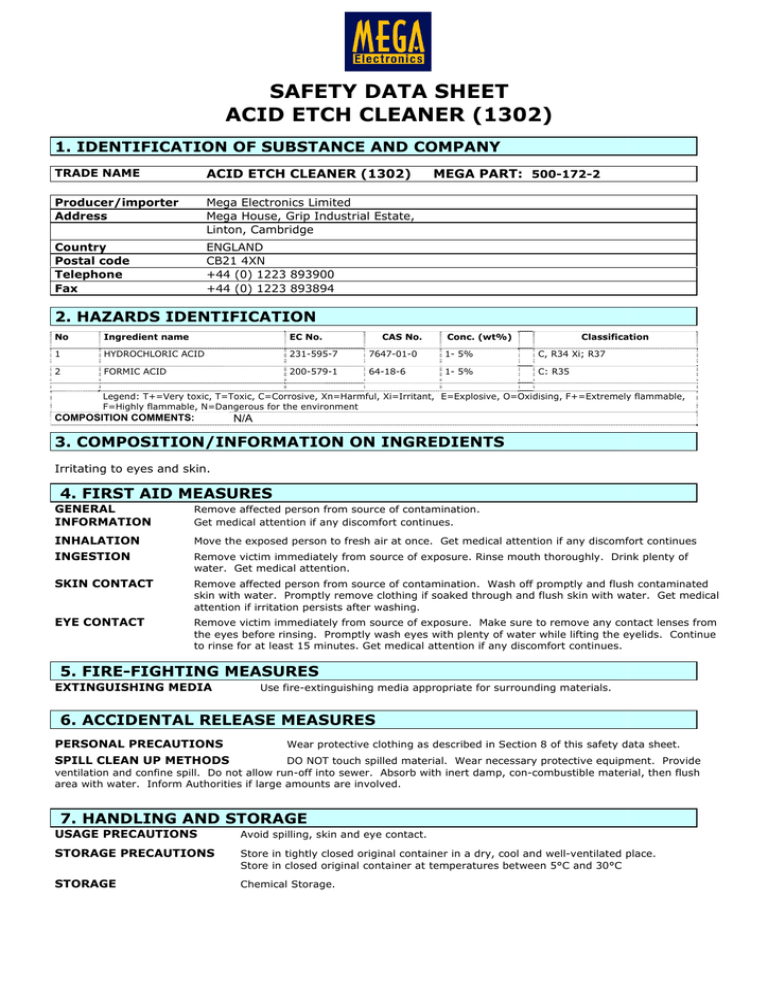
SAFETY DATA SHEET ACID ETCH CLEANER (1302) 1. IDENTIFICATION OF SUBSTANCE AND COMPANY TRADE NAME ACID ETCH CLEANER (1302) Producer/importer Address Mega Electronics Limited Mega House, Grip Industrial Estate, Linton, Cambridge Country Postal code Telephone Fax ENGLAND CB21 4XN +44 (0) 1223 893900 +44 (0) 1223 893894 MEGA PART: 500-172-2 2. HAZARDS IDENTIFICATION No Ingredient name EC No. 1 HYDROCHLORIC ACID 231-595-7 7647-01-0 CAS No. 1- 5% Conc. (wt%) C, R34 Xi; R37 Classification 2 FORMIC ACID 200-579-1 64-18-6 1- 5% C: R35 Legend: T+=Very toxic, T=Toxic, C=Corrosive, Xn=Harmful, Xi=Irritant, E=Explosive, O=Oxidising, F+=Extremely flammable, F=Highly flammable, N=Dangerous for the environment COMPOSITION COMMENTS: N/A 3. COMPOSITION/INFORMATION ON INGREDIENTS Irritating to eyes and skin. 4. FIRST AID MEASURES GENERAL INFORMATION Remove affected person from source of contamination. Get medical attention if any discomfort continues. INHALATION INGESTION Move the exposed person to fresh air at once. Get medical attention if any discomfort continues SKIN CONTACT Remove affected person from source of contamination. Wash off promptly and flush contaminated skin with water. Promptly remove clothing if soaked through and flush skin with water. Get medical attention if irritation persists after washing. EYE CONTACT Remove victim immediately from source of exposure. Make sure to remove any contact lenses from the eyes before rinsing. Promptly wash eyes with plenty of water while lifting the eyelids. Continue to rinse for at least 15 minutes. Get medical attention if any discomfort continues. Remove victim immediately from source of exposure. Rinse mouth thoroughly. Drink plenty of water. Get medical attention. 5. FIRE-FIGHTING MEASURES EXTINGUISHING MEDIA Use fire-extinguishing media appropriate for surrounding materials. 6. ACCIDENTAL RELEASE MEASURES PERSONAL PRECAUTIONS Wear protective clothing as described in Section 8 of this safety data sheet. SPILL CLEAN UP METHODS DO NOT touch spilled material. Wear necessary protective equipment. Provide ventilation and confine spill. Do not allow run-off into sewer. Absorb with inert damp, con-combustible material, then flush area with water. Inform Authorities if large amounts are involved. 7. HANDLING AND STORAGE USAGE PRECAUTIONS Avoid spilling, skin and eye contact. STORAGE PRECAUTIONS Store in tightly closed original container in a dry, cool and well-ventilated place. Store in closed original container at temperatures between 5°C and 30°C STORAGE Chemical Storage. 8. EXPOSURE CONTROL/PERSONAL PROTECTION name HYDROCHLORIC ACID Std LT- ppm LT – mg/m3 FORMIC ACID OES 5 ppm 9.6 mg/m3 ST –ppm ST – mg/m3 PROTECTIVE EQUIPMENT WEL = WORKPLACE EXPOSURE LIMITS. PROCESS CONDITIONS Use engineering controls to reduce air contamination to permissible exposure level. ENGINEERING MEASURES Provide adequate general and local exhaust ventilation. RESPIRATORY EQUIPMENT Respiratory protection must be used if air contamination exceeds acceptable level. HAND PROTECTION Use protective gloves. EYE PROTECTION Wear approved safety goggles. OTHER PROTECTION Wear appropriate clothing to prevent any possibility of skin contact. HYGIENE MEASURES DO NOT SMOKE IN WORK AREA! Wash at the end of each work shift and before eating, smoking and using the toilet. Promptly remove any clothing that becomes contaminated. Wash promptly with soap & water if skin becomes contaminated. When using do not eat, drink or smoke. 9. PHYSICAL AND CHEMICAL PROPERTIES Physical State: Colour: Solubility: Relative Density: Clear Liquid. Colourless. soluble in water. 1.035 – 1.039 @ 20°C pH Value: <1 10. STABILITY AND REACTIVITY STABILITY Stable under normal temperature conditions. HAZARDOUS DECOMPOSITION PRODUCTS Irritating gases/vapours/fumes of: Hydrogen chloride (HCI). Formic acid. 11. TOXICOLOGICAL INFORMATION INHALATION May cause irritation to the respiratory system. INGESTION May cause discomfort if swallowed SKIN CONTACT Irritating to skin EYE CONTACT Irritating to eyes 12. ECOLOGICAL INFORMATION NAME HYDROCHLORIC ACID. Bioaccumulation This product is not bio-accumulating. Acute Fish Toxicity Concentrations which give low pH may be fatal to fish and aquatic organisms NAME FORMIC ACID. Mobility This product is soluble in water. Bioaccumulation Will not bio-accumulate Acute Fish Toxicity Not considered toxic to fish. 13. DISPOSAL CONSIDERATIONS DISPOSAL METHODS Dispose of waste and residues in accordance with local authority requirements. 14. TRANSPORT INFORMATION GENERAL This product is not covered by international regulation on the transport of dangerous goods (IMDG, IATA, ADR/RID) No Transport warning sign required. MARINE POLLUTANT No 15. REGULATORY INFORMATION Irritant LABELLING R-PHRASES R36/38 Irritating to eyes and skin S-PHRASES S26 In case of contact with eyes, rinse immediately with plenty of water and seek medical advice. S24/25 Avoid contact with skin and eyes. S60 This material and its container must be disposed of as hazardous waste. UK REGULATORY REFERENCES Health and Safety at Work Act 1974. The Control of Substances Hazardous to Health Regulations. STATUTORY INSTRUMENTS Chemicals (Hazard Information and Packaging) Regulations. Control of Substances Hazardous to Health. GUIDANCE NOTES Workplace Exposure Limits EH40. 16. OTHER INFORMATION INFORMATION SOURCES: Dangerous Properties of Industrial Chemicals, N.Sax, Croner's: Dangerous Substances. Croner's: Emergency Spillage Guide. Croner's: Substances Hazardous to Health. Material Safety Data Sheet, Misc. manufacturers. REVISION DATE: 26/04/2006 Revised 26.11.2010 REV. NO./REPL. SDS GENERATED 3 RISK PHRASES IN FULL R34 Causes burns. R35 Causes severe burns. R37 Irritating to respiratory system. This information relates to the specific material designated and may not be valid for such material used in combination with any other materials or in any process. Such information is, to the best of the company’s knowledge and belief, accurate and reliable as of the date indicated. However no warranty guarantee or representation is made to its accuracy, reliability or completeness. It is the user’s responsibility to satisfy him/herself as to the suitability of such information for his/her own particular use.
